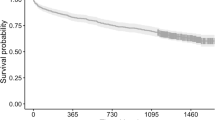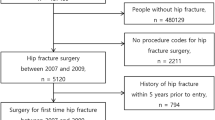Abstract
Purpose
To assess the impact of the comprehensive orthogeriatric care model (OGM) on 2-year survival, length of stay (LOS), discharges to nursing homes, and antiosteoporotic treatment (AOT) in patients with hip fracture.
Methods
Retrospective cohort study. Hospitals were classified as OGM if the patient was cared for in a comprehensive orthogeriatric unit. We included data from patients ≥ 65 years old discharged between 2012 and 2013. The main outcome was 12- and 24-month mortality. The variables collected were sex, type of fracture, comorbidities, AOT, LOS, and discharge to nursing homes. Survival analysis was performed with Kaplan–Meier method and comparison with Mantel–Haenszel test. Factors associated with death were determined by logistic regression.
Results
First admissions in the 12 (out of 32) hospitals with OGM were 3580 of 9215 (38.8%). Patients in OGM had more comorbidities and discharges to nursing homes, shorter LOS, and less prescription of AOT. Two years after the admission the deceased patients were 3000 (32.6%). The survival was lower in males (p < 0.001), in the older age groups (p < 0.001), and in patients with Charlson > 1 (p < 0.001). Factors associated with increased risk of death at 12 and 24 months (logistic regression) were male gender, age and Charlson > 1, while care in the OGM decreased the risk. OGM benefited more patients > 80 years and those with Charlson < 1.
Conclusions
Patients admitted in OGM have shorter stays, more discharges to nursing homes, lower prescription of AOT, and better 12- and 24-month survival adjusted by sex, age, and comorbidities compared to non-OGM care.

Similar content being viewed by others
References
Pueyo-Sánchez MJ, Larrosa M, Surís X, Casado E, Auleda J, Fusté J, Ortún V (2017) Secular trend in the incidence of hip fracture in Catalonia, Spain, 2003–14. Age Ageing 46:324–328
Observatori del Sistema de Salut de Catalunya (2015) Central de Resultats. Processos. La fractura de coll de fèmur en població de 65 anys o més. Dades 2014. Barcelona: Agència de Qualitat i Avaluació Sanitàries de Catalunya. Departament de Salut. Generalitat de Catalunya. http://observatorisalut.gencat.cat/web/.content/minisite/observatorisalut/ossc_central_resultats/informes/fitxers_estatics/processos-femur.pdf. Last Access 12 May 2017
Cruz Jentoft AJ, Serra Rexach JA, Lázaro del Nogal M et al (1994) The efficacy of geriatric consultation in elderly patients admitted to traumatology services. An Med Intern (Madrid) II:273–277
González-Montalvo JI, Gotor Pérez P, Martin Vega A et al (2011) The acute orthogeriatric unit. Assessment of its effect on the clinical course of patients with hip fractures and an estimate of its financial impact. Rev Esp Geriatr Gerontol 46(4):193–199
Sabharwal S, Wilson H (2015) Orthogeriatrics in the management of frail older patients with a fragility fracture. Osteoporos Int 26:2387–2399
Grigoryan KV, Javedan H, Rudolph JL (2014) Ortho-geriatric care models and outcomes in hip fracture patients: a systematic review and meta-analysis. J Orthop Trauma 28(3):e49–e55
Buecking B, Timmesfeld N, Riem S et al (2013) Early orthogeriatric treatment of trauma in the elderly—a systematic review and metaanalysis. Dtsch Arztebl Int 110(15):255–262. https://doi.org/10.3238/arztebl.2013.0255
Suhm N, Kaelin R, Studer P, Wang Q, Kressig RW, Rikli D et al (2014) Orthogeriatric care pathway: a prospective survey of impact on length of stay, mortality and institutionalisation. Arch Orthop Trauma Surg 134:1261–1269
Middleton M, Wan B, da Assunçao R (2016) Improving hip fracture outcomes with integrated orthogeriatric care: a comparison between two accepted orthogeriatric models. Age Ageing. https://doi.org/10.1093/ageing/afw232
Heltne M, Saltvedt I, Lydersen S, Prestmo A, Sletvold O (2017) Spigset O Patterns of drug prescriptions in an orthogeriatric ward as compared to orthopaedic ward: results from de Trondheim Hip Fracture Trial—a randomised clinical trial. Eur J Clin Pharmacol 73:937–947
Friedman SM, Mendelson DA, Bingham KW, Kates SL (2009) Impact of a comanaged Geriatric Fracture Center on short-term hip fracture outcomes. Arch Intern Med 169:1712–1717
Leal J, Gray AM, Hawley S et al (2016) Cost-effectiveness of orthogeriatric and fracture liaison service models of care for hip fracture patients: a population-based study. J Bone Miner Res. https://doi.org/10.1002/jbmr.2995
Ginsberg G, Adunsky A, Rasooly I (2013) A cost-utility analysis of a comprehensive orthogeriatric care for hip fracture patients, compared with standard of care treatment. Hip Int 23(6):570–575
Vidan M, Serra JA, Moreno C, Riquelme G, Ortiz J (2005) Efficacy of a comprehensive geriatric intervention in older patients hospitalized for hip fractures: a randomized controlled trial. J Am Geriatr Soc 53:1476–1482
Zeltzer J, Mitchell RJ, Toson B, Harris IA, Ahmad L, Close J (2014) Orthogeriatric services associated with lower 30-day mortality for older patients who undergo surgery for hip fracture. Med J Aust 201(7):409–411
Stenqvist C, Madsen CM, Riis T, Jorgensen HL, Duus BR, Lauritzen JB et al (2016) Orthogeriatric services reduces mortality in patients with hip fracture. Geriatr Orthop Surg Rehabil 7(2):67–73
Gosch M, Hoffmann-Weltin Y, Roth T, Blauth M, Nicholas JA, Kammerlander C (2016) Orthogeriatric co-management improves the outcom of long-term care residents with fragility fractures. Arch Orthop Trauma Surg 136(10):1403–1409
Folbert EC, Hegeman JH, Vermeer M et al (2017) Improved 1-year mortality in elderly patients with a hip fracture following integrated orthogeriatric treatment. Osteoporos Int 28(1):269–277
Hawley S, Javaid MK, Prieto-Alhambra D, Lippett J, Sheard S, Arden NK et al (2016) Clinical effectiveness of orthogeriatric and fracture liaison service models of care for hip fracture patients: population-based longitudinal study. Age Ageing 45(2):236–242
Henderson CY, Shanahan E, Butler A, Lenehan B, O’Connor M, Lyons D et al (2017) Dedicated orthogeriatric service reduces hip fracture mortality. Ir J Med Sci 186(1):179–184
Generalitat of Catalonia (2010) Ministry of Health. Master Plan for Musculoskeletal Diseases. Barcelona. http://salutweb.gencat.cat/web/.content/home/ambits_tematics/linies_dactuacio/planificacio/plans_directors_2008-2010/malalties_reumatiques_i_de_laparell_locomotor/linies_estrategiques/pdmral.PDF. Accessed 12 Feb 2016
Generalitat of Catalonia (2006) Ministry of Health. Master Plan for Health and Social Care. Barcelona. http://salutweb.gencat.cat/web/.content/home/ambits_tematics/linies_dactuacio/salut_i_qualitat/plans_directors/sociosanitari/pla_director/documents/PDsociosanitari_2017_2019.pdf. Accessed 12 Feb 2016
Kates SL, O’Malley N, Friedman SM, Mendelson DA (2012) Barriers to implementation of an organized geriatric fracture program. Geriatr Orthoped Surg Rehabil 3(1):8–16
Meessen JM, Pisani S, Gambino ML, Bonarrigo D, van Schoor NM, Fozzato S, Cherubino P, Surace MF (2014) Assessment of mortality risk in elderly patients after proximal femoral fracture. Orthopedics 37(2):e194–e200
Trombetti A, Herrmann F, Hoffmeyer P, Schurch MA, Bonjour JP, Rizzoli R (2002) Survival and potential years of life lost after hip fracture in men and age-matched women. Osteoporos Int 13:731–737
Holviq K, Ranhoff AH, Martinsen MI, Soldheim LF (2010) Predictors of mortality in older hip fracture inpatients admitted to an orthogeriatric unit in Oslo, Norway. J Aging Health 22(8):1114–1131
Henderson CY, Ryan JP (2015) Predicting mortality following hip fracture: an analysis of comorbidities and complications. Ir J Med Sci 184:667–671
Prestmo A, Hagen G, Sletvold O, Helbostad JL, Thingstad P, Taraldsen K et al (2015) Comprehensive geriatric care for patients with hip fractures: a prospective, randomised, controlled trial. Lancet 25(385):1623–1633
Prestmo A, Saltveldt I, Helbostad JL, Taraldsen K, Thingstad P, Lydersen S et al (2016) Who benefits from orthogeriatric treatment? Results from the Trondheim hip-fracture trial. BMC Geriatr 16:49
Watne LO, Torgbersen AC, Conroy S, Engedal K, Frihagen F, Hjorthaug GA et al (2014) The effect of a pre- and postoperative orthogeriatric service on cognitive function in patients with hip fracture: randomized controlled trial (Oslo Orthogeriatric Trial). BMC Med 12(1):63
Sáez López P, González Montalvo JI, Alarcón T, Madruga F, Barcena A (2006) Optimization of medical treatment in a geriatric patient with hip fracture. Influence of the consulting team. Rev Esp Geriatr Gerontol 41:85–91
Kim SC, Kim MS, Sanfélix-Gimeno G et al (2015) Use of osteoporosis medications after hospitalization for hip fracture: a cross-national study. Am J Med 128:519–526
Klop C, Gibson-Smith D, Elders PJM et al (2015) Anti-osteoporosis drug prescribing after hip fracture in the UK: 2000–2010. Osteoporos Int 26:1919–1928
Hawley S, Leal J, Delmestri A et al (2016) Anti-osteoporosis medication prescriptions and incidence of subsequent fracture among primary hip fracture patients in England and wales: an interrupted time-series analysis. J Bone Miner Res. https://doi.org/10.1002/jbmr.2882
Peng J, Liu Y, Chen L et al (2016) Bisphosphonates can prevent hip fracture and redice the mortality in osteoporotic patient with hip fracture: a meta-analysis. Pak J Med Sci 32(2):499–504
Beaupre LA, Mirrish DA, Maksymowych WP et al (2011) Oral bisphosphonates are associated with reduced mortality after hip fracture. Osteoporos Int 22(3):983–991
Índex de Qualitat de la Prescripció Farmacèutica (IQF). Versió (2015) Barcelona: Agència de Qualitat i Avaluació Sanitàries de Catalunya. Servei Català de la Salut. Departament de Salut. Generalitat de Catalunya; 2015. (Programa d’Innovació i Suport a l’Àmbit del Medicament;01/2015). http://catsalut.gencat.cat/web/.content/minisite/catsalut/proveidors_professionals/medicaments_farmacia/catsalut_entitats/iqpf_2014.pdf. Last Access 27 Dec 2017
Dubljanin-Rapopovic E, Markovic-Denic L, Marinkovic J, Nedeljjovic U, Bumbasirevic M (2013) Does early functional outcome predict 1-year mortality in elderly patients with hip fracture? Clin Orthop Relat Res 471(8):2703–2710
Funding
This research did not receive any specific grant from funding agencies in the public, commercial or not-for-profit sectors.
Author information
Authors and Affiliations
Contributions
MJP, ML, XS, PSF, and IB have made substantial contributions to the design, acquisition of data, analysis and interpretation of results. MJP has drafted the manuscript. ML, XS, PSF, IB, EFC, and VO have revised the article critically for important intellectual content. All the authors have revised the final version of the manuscript.
Corresponding author
Ethics declarations
Conflict of interest
All the authors declare that they have no conflict of interest.
Ethical approval
All procedures performed in this study were in accordance with the ethical standards of the Department of Health of Catalonia and with the 1964 Helsinki declaration and its later amendements or comparable ethical standards.
Informed consent
All the data were anonymised and used in an aggregated manner. So the informed consent was unnecessary.
Rights and permissions
About this article
Cite this article
Pueyo-Sánchez, MJ., Larrosa, M., Surís, X. et al. Association of orthogeriatric services with long-term mortality in patients with hip fracture. Eur Geriatr Med 9, 175–181 (2018). https://doi.org/10.1007/s41999-018-0028-4
Received:
Accepted:
Published:
Issue Date:
DOI: https://doi.org/10.1007/s41999-018-0028-4




